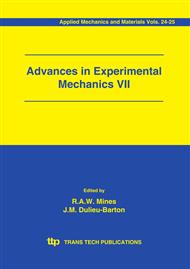p.227
p.233
p.239
p.245
p.253
p.261
p.267
p.275
p.281
Evaluation of the Impact of Residual Stresses in Crack Initiation with the Application of the Crack Compliance Method Part I, Numerical Analysis
Abstract:
The understanding of how materials fail is still today a fundamental research problem for scientist and engineers. The main concern is the assessment of the necessary conditions to propagate a crack that will eventually lead to failure. Nevertheless, this kind of analysis tends to be more complicated, when a prior history in the material is taken into consideration and it will be extremely important to recognize all the factors involved in this process. In this work, a numerical simulation of the introduction of residual stresses, which change the crack initiation conditions, in a modified compact tensile specimen to change the condition of crack initiation is presented. Four numerical analyses were carried out; an initial evaluation was performed in a specimen without a crack and it was used for the estimation of a residual stress field produced by an overload; three more cases were simulated and a crack was introduced in each specimen (1 mm, 5 mm and 10 mm, respectively). The overload was then applied to set up a residual stress field into the component; furthermore, in each case the crack compliance method (CCM) was applied to measure the induced residual stress field. By performing this numerical simulation, the accuracy of the crack compliance method can be evaluated. On the other hand, elastic-plastic finite element analysis was utilized for the residual stress estimation. The numerical analysis was based on the mechanical properties of a biocompatible material (AISI 316L). The obtained results provided significant data about diverse factors, like; the manner in which a residual stress field could modify the crack initiation conditions, the convenient set up for induction of a beneficial residual stresses field, as well as useful information that can be applied for the experimental implementation of this research.
Info:
Periodical:
Pages:
253-259
Citation:
Online since:
June 2010
Permissions:
Share:
Citation:


